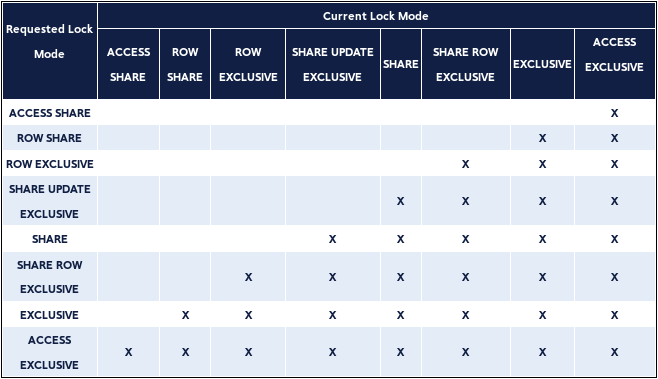
Imagine you have the customer’s bank account where he can withdraw the money.
#Postgres deadlock update#
When data is updated or deleted, PostgreSQL will note the change in the write-ahead log (WAL), update the page in memory, and mark it as “dirty.” PostgreSQL periodically runs checkpoint processes to flush these dirty pages from memory to disk, to ensure that data is up to date, not only in memory but also on disk.In the current project we faced the problem of concurrent changes to database, for the data that should be accessed sequentially. In order to speed up queries, PostgreSQL uses a certain portion of the database server’s memory as a shared buffer cache (128MB by default), to store recently accessed blocks in memory. Each transaction operates on its own snapshot of the database at that point in time, so that read queries won’t block write queries, and vice versa. When a query involves updating or deleting data, PostgreSQL uses multi-version concurrency control (MVCC) to ensure that data remains accessible and consistent in high-concurrency environments. In order to do so, it accounts for a number of factors, including whether or not the data in question has been indexed, as well as internal statistics about the database, like the number of rows in each table. PostgreSQL uses a query planner/optimizer to determine the most efficient way to execute each query.

In PostgreSQL, each table (or relation) stores rows of data as an array of 8-KB pages, or blocks. Thus, the two transactions wait for each other. However, the first transaction also waits for the lock on row(id=8) to be released. So, here the first transaction holds a row-level lock on the row id=2, while the second transaction holds a row-level lock on the row(id=8) and waits for the lock on row(id=2) to be released. UPDATE users set name='John' where id = 8 UPDATE users set name='John' where id = 8 UPDATE users set name='John' where id = 2 Īnd the first transaction wants to update like: UPDATE users set name='John' where id = 2 Īnd the second transaction concurrently updates like: PostgreSQL detects this and aborts one of the transactions. For example, when two transactions hold locks that the other wants, then the transaction will wait for each other, and this is a deadlock. DEADLOCKSĮxplicit locks usage can increase the probability of deadlocks. So, a second transaction can acquire the same type of lock, but cannot modify or delete the rows selected, or acquire any exclusive locks on them. Select * from table where id > 10 and id 10 and id < 15 FOR SHARE This SQL command acquires an exclusive row-level lock without actually modifying. Row-level locks do not block data querying, only block other transactions which modifies the same rows. Exclusive locks are automatically acquired when rows are updated or deleted. There are two types of row-level locks such as shared and exclusive. This is also the default lock mode for LOCK TABLE statements that do not specify a mode explicitly. ACCESS EXCLUSIVEĪcquired by the ALTER TABLE, DROP TABLE, TRUNCATE, REINDEX, CLUSTER, VACUUM FULL, and REFRESH MATERIALIZED VIEW (without CONCURRENTLY) commands.

PostgreSQL does not automatically acquire this type of lock. SHAREĬREATE INDEX(without concurrently) acquires this lock. SHARE UPDATE EXCLUSIVEĪcquired by VACUUM, ANALYZE, CREATE INDEX CONCURRENTLY and some forms of ALTER TABLE commands. In general, any query that modifies data will hold this lock. INSERT, UPDATE, DELETE commands acquire this lock.

SELECT FOR UPDATE and SELECT FOR SHARE commands acquire this lock. In general, any query that only reads but not modifies data will have hold this lock. ACCESS SHAREĪ SELECT command acquires this type of lock. This types of locks are automatically acquired by PostgreSQL. Locks are released when the transaction is committed or rollbacked. Non-conflicting locks can be held by multiple transactions concurrently. That is a transaction can hold ACCESS EXCLUSIVE and ACCESS SHARE locks at the same time. So, the second transaction should wait in a queue for the first one to release the lock.Ī transaction never conflicts itself. For example, when an ACCESS EXCLUSIVE lock is acquired by a transaction, a second transaction cannot acquire any locks, since ACCESS EXCLUSIVE conflicts all the other type of locks. Locks can also be explicitly acquired by users. Some locks are acquired implicitly by PostgreSQL when, for example, an SQL statement is run. Postgresql provides 3 different types of lock such as table-level locks, row-level locks, and advisory locks.


 0 kommentar(er)
0 kommentar(er)
